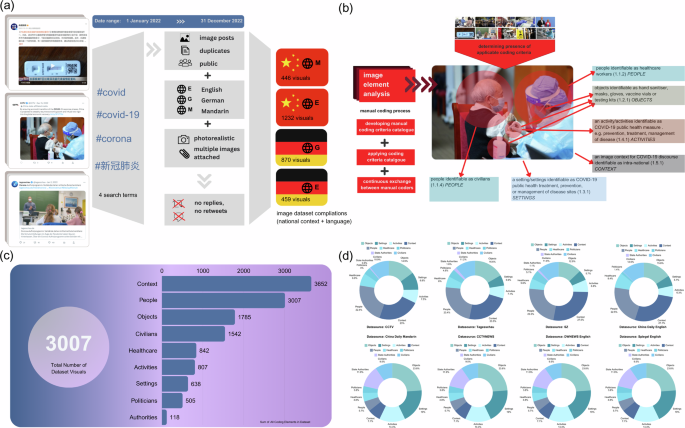Understanding Visual Messaging in Health Communication: A Comparative Analysis of Social Media Outlets
In the age of digital communication, visual content has become a pivotal element in conveying information, especially during healthcare emergencies like the COVID-19 pandemic. This article delves into a comparative analysis of the number and composition of images shared across various social media platforms, focusing on how these visuals influence public perception and response to health crises.
Image Collection Across Platforms
The number of images collected for this study varied significantly across different social media platforms. As illustrated in Figure 1, the data reveals a diverse landscape of visual messaging. Table 2 provides a detailed breakdown of the specific number of images coded for each social media outlet, highlighting the disparities in image usage. While the limited number of observations restricts the application of rigorous statistical tests, the identification of patterns within the populations of posts underscores the necessity for further research into the role of visual messaging in shaping societal responses to healthcare emergencies.
Image Composition by Media Outlet
Figures 2 and 3 present descriptive graphs that illustrate the total number of images and their topic composition across eight media outlets: ‘@CCTV’ (China/English), ‘CCTVNEWS’ (China/Mandarin), ‘@ChinaDaily’ (China/English), ‘China Daily’ (China/Mandarin), ‘@dwnews’ (Germany/English), ‘@SPIEGEL_English’ (Germany/English), ‘@SZ’ (Germany/German), and ‘@tagesschau’ (Germany/German). Notably, ‘@ChinaDaily’ on Twitter/X emerged as the outlet with the highest image count, exceeding 4,000 images, while ‘@SPIEGEL_English’ had a mere 11 samples. This stark contrast highlights the varying engagement levels and strategies employed by different outlets in visual communication.
The topic composition of these images also reveals intriguing differences. For instance, the proportion of Context images is notably higher in CCTVNews compared to other outlets, while German-based outlets tend to feature a larger share of images depicting People. This variation suggests that cultural and geographical factors play a significant role in shaping the visual narratives presented by these media outlets.
Cultural, Geographical, and Linguistic Dynamics
The analysis further uncovers the influence of cultural and linguistic dynamics on image usage. English-language outlets in China reported the highest image count, totaling 4,239 images in 2022, while Mandarin outlets posted only 1,634 images. German-language outlets, in their communication regarding COVID-19 and public health measures, shared 2,833 images, with German outlets communicating in English showing the lowest count at 1,183 images.
Figures 4 and 5 provide a comparative analysis of the total images published across media outlets in English, Mandarin, and German. The data indicates a stronger emphasis on Context images in Mandarin outlets compared to the prominence of People images in German outlets. This suggests that the cultural context significantly influences the types of visuals used in health communication.
Image Composition by Language and Location
Table 3 presents a comprehensive overview of the total number of images per topic and the proportion of images categorized by language and location. This multi-layered analysis reveals distinct patterns in visual composition. Figures 6 and 7 further illustrate the distribution of image content, focusing on the representation of different types of individuals—politicians, healthcare workers, civilians, and executive authorities.
The findings indicate that Mandarin-language outlets in China tend to feature a higher proportion of politicians in their imagery compared to their German or English-language counterparts. Conversely, German outlets, regardless of language, prioritize images of healthcare workers and civilians. This trend highlights the varying emphasis placed on different groups within the visual narratives of health communication.
Visual Composition Patterns
The analysis of image types across country-language pairs reveals consistent patterns, with notable differences emerging in the emphasis placed on various image elements. For instance, Germany/English communications utilize images of people more frequently (39% of all images) than any other country/language pair, while China/Mandarin communications prioritize Context images, accounting for 49% of all images.
These differences suggest distinct communication strategies employed by various outlets. Mandarin-language outlets in China prioritize Context images and Politicians, while China/English outlets focus more on Healthcare Workers and Civilians. This contrast is less pronounced in Germany, where both German and English-language outlets exhibit similar patterns.
Implications for Public Health Communication
Understanding these differences in visual messaging is crucial for developing effective public health communication strategies. The preliminary findings of this study indicate that the language and cultural context in which an outlet operates significantly influence the types of images used. By further analyzing these variations, researchers and policymakers can gain valuable insights into how visual communication strategies impact public health responses.
In conclusion, the role of visual messaging in health communication is multifaceted and deeply influenced by cultural, geographical, and linguistic factors. As the digital landscape continues to evolve, ongoing research in this area will be essential for enhancing public health communication strategies and ensuring that critical health information reaches diverse populations effectively.
